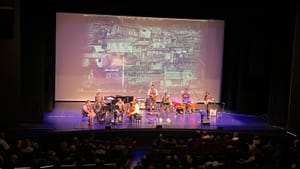Stay in the Loop
BSR publishes on a weekly schedule, with an email newsletter every Wednesday and Thursday morning. There’s no paywall, and subscribing is always free.
A vision in sound
Penn Live Arts presents Terence Blanchard and Andrew F. Scott’s Gordon Parks: An Empathetic Lens

The Philadelphia premiere of Gordon Parks: An Empathetic Lens celebrated its namesake in both images and sound in a performance at Penn Live Arts. Visuals created by Andrew F. Scott, an artist working at the intersection of fine arts and digital fabrication, accompanied the stirring musical tribute performed by Terence Blanchard and the E-Collective with the Turtle Island Quartet.
Recipient of the Library of Congress’s Living Legend award, Gordon Parks (1912-2006) was a talented multimedia Renaissance man who may be best known for directing the movie Shaft (1971). However, he used art, particularly photography and film, to explore social-justice themes. Since 2015, exhibitions of his photographs, including his work for the Farm Security Administration as well as magazines like Vogue and Ebony, have renewed interest in Parks.
“What America should be”
Starting with the music itself, An Empathetic Lens took a fittingly interdisciplinary approach to the artist who regarded art as a weapon against poverty and bigotry. Blanchard, a trumpeter and composer who has created many film scores, embraces an expansive view of jazz. His E-Collective is an electric ensemble that includes guitar, bass, piano, and drums. Meanwhile, the Turtle Island Quartet is a string quartet that plays hybrids of jazz, classical, and rock music. The all-male performers spanned a range of ages, races, ethnicities, and backgrounds, musical and otherwise. Blanchard noted the diversity on stage when he introduced the band midway through the show, noting that “this is what America should be.”
The music was as eclectic as Parks’s own work, which appeared on a screen behind the performers, and sometimes as powerful. As the musicians took the stage, Parks's photographs flashed on the screen. Throughout the performance, ghostly live projections of the musicians were superimposed upon the photos, highlighting the connection between these artists and Parks, and between past and present. Bassist David Ginyard Jr. composed the opening piece, which paired images like an empty schoolroom with urgent piano and Blanchard’s plaintive trumpet while the Turtle Island Quartet’s strings added haunting depth.
Fort Scott and Beethoven
The second number featured images from the extraordinary Back to Fort Scott series from 1950, which depicts Black citizens in Parks’s Kansas hometown. A drum solo kicked off the music, and Blanchard’s trumpet came in distorted before shrieking as piano notes unspooled. On the screen, Parks's photos came to life in strange, sometimes unsettling ways. The still image of a woman in a rocking chair became animated, so that she rocked back and forth and blinked. A painted image of Parks appeared, then pixelated. Both captivating and distracting, the images paired well with the music and the compelling quality of the artist’s photos and their message.

Funky bass kicked off the next song, in which Turtle Island’s string signatures evoked both Beethoven’s Symphony Number Five and Walter Murphy’s 1976 disco version “A Fifth of Beethoven.” The strings gave way to trumpet, then a piano solo over a bass heartbeat. Charles Altura’s guitar solo stood out for using an effect to create sounds that seemed to come from outer space. Scott’s visuals heightened this as Parks's photos swirled in three-dimensional reels on the screen. The Turtle Island Quartet shone as the Beethoven-esque sounds returned, then distilled the strings into a single thrum.
Eclectic urgency and emotion
Blanchard and the E-Collective next played on their own, juxtaposing Parks’s poem “The Funeral” with looping guitar and gently soaring electric keyboard. When Turtle Island returned to the stage, their surge of strings supported Blanchard’s trumpet refrain as Parks’s portraits of Muhammad Ali appeared on the screen. Next, founding member and violinist David Balakrishnan introduced himself and the other members of the Turtle Island Quartet—Benjamin von Gutzeit on cello, Gabriel Terracciano on violin, Zack Brown on cello—before they played a complex, ever-evolving piece on their own.
Blanchard took the mic to describe the time he met Parks. He also discussed his initial intent for the E-Collective, but the band soon shifted its focus from showing young people a world beyond electronic music to engaging with the problem of gun violence. In recognition of that, Blanchard dedicated a song to social workers. Before the performance concluded, he revealed that Scott, the visual artist who created the images and visual effects accompanying the music, is a friend from his youth.
An artist ahead of his times, Parks created profound work in many mediums. His documentary photojournalism tackled challenging topics like inequality, labor, and poverty while depicting people with empathy and dignity. Gordon Parks: An Empathetic Lens takes a more abstract approach to its subject, yet it captures Parks’s embrace of varied forms of media and expression. From Scott’s visuals to the layered, jazzy sounds from Blanchard and the E-Collective with the Turtle Island Quartet, An Empathetic Lens reflected the urgency and emotion of Parks’s photos.
What, When, Where
Gordon Parks: An Empathetic Lens. By Terence Blanchard and Andrew F. Scott, with E-Collective and the Turtle Island Quartet; presented by Penn Live Arts. $29-$67. November 12, 2022, at the Zellerbach Theater of Penn Live Arts, 3680 Walnut Street, Philadelphia. (215) 898-3900 or pennlivearts.org.
Accessibility
Masks were encouraged, but not required.
Penn Live Arts offers wheelchair-accessible seating, free admission for personal care attendants, large-print programs, and assistive listening devices. Visit the venue’s accessibility page for more info.
Sign up for our newsletter
All of the week's new articles, all in one place. Sign up for the free weekly BSR newsletters, and don't miss a conversation.

 Melissa Strong
Melissa Strong